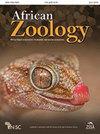南非Loskop水坝红鼻拉贝(Labeo rosae)肝脏和鳃的组织病理学
IF 0.5
4区 生物学
Q4 ZOOLOGY
引用次数: 2
摘要
Loskop大坝是Olifants河污染最严重的蓄水池,因为它接收来自整个以矿山为主的上游流域的污染物。然而,居住在这座被污染的大坝上的鱼类的组织病理学研究却很少。本研究旨在研究Loskop水坝玫瑰的鳃和肝脏的组织病理学。在整个研究过程中观察到碱性pH,大多数金属浓度超过了水生生态系统的水质指南。退行性变化是两个器官中最突出的病变,鳃的病变相对多于肝脏。在这两个季节,鳃中的上皮隆起都是100%普遍的,而肝脏中富含脂褐素的黑巨噬细胞(MMC)的显著扩张显示出100%的普遍性。Gills在两个季节的组织病理学患病率上有显著差异,而肝脏的情况并非如此。本研究中记录的组织病理学表明,Loskop大坝的玫瑰乳杆菌的健康受到了损害。鉴于Olifants河上游的污染水平不断加剧,这些发现向保护当局发出了警告,并强调有必要定期监测Loskop大坝的鱼类健康状况,以评估污染水平,将鱼类健康状况作为改变污染水平的敏感指标。本文章由计算机程序翻译,如有差异,请以英文原文为准。
Histopathology of the Liver and Gills of Labeo rosae (Rednose Labeo) from Loskop Dam in South Africa
The Loskop Dam is the most polluted impoundment in the Olifants River, because it receives pollutants from the entire mine-dominated upper catchment. However, histopathology of fish inhabiting this polluted dam is scantly explored. The current study aimed to investigate the histopathology of the gills and liver of Labeo rosae from Loskop Dam. Alkaline pH was observed throughout the study with most metal concentrations exceeding the water quality guideline for aquatic ecosystems. Regressive changes were the most prominent lesions for both organs with gills showing relatively more pathologies than the liver. Epithelial lifting was 100% prevalent during both seasons in the gills whereas a significant expansion of lipofuscin-laden melanomacrophages (MMCs) showed 100% prevalence in the liver. Gills were significantly different in their prevalence of histopathology between the two seasons, which was not the case for liver. The histopathology recorded in this study shows that the health of L. rosae at Loskop Dam was compromised. Given the exacerbating pollution level in the upper Olifants River, these findings serve as a warning to conservation authorities and emphasise the necessity for regular monitoring of fish health at Loskop Dam to assess pollution levels using fish health as a sensitive indicator to altering pollution levels.
求助全文
通过发布文献求助,成功后即可免费获取论文全文。
去求助
来源期刊

African Zoology
生物-动物学
CiteScore
2.60
自引率
9.10%
发文量
18
审稿时长
>12 weeks
期刊介绍:
African Zoology , a peer-reviewed research journal, publishes original scientific contributions and critical reviews that focus principally on African fauna in terrestrial, freshwater, and marine ecosystems. Research from other regions that advances practical and theoretical aspects of zoology will be considered. Rigorous question-driven research in all aspects of zoology will take precedence over descriptive research. The Journal publishes full-length papers, critical reviews, short communications, letters to the editors as well as book reviews. Contributions based on purely observational, descriptive or anecdotal data will not be considered.
The Journal is produced by NISC in association with the Zoological Society of South Africa (ZSSA). Acceptance of papers is the responsibility of the Editors-in-Chief in consultation with the Editors and members of the Editorial Advisory Board. All views expressed are those of the author and not necessarily those of the Editors or the Department.
 求助内容:
求助内容: 应助结果提醒方式:
应助结果提醒方式:


